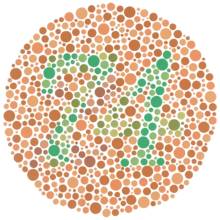Ishihara Shinobu

Ishihara Shinobu ( Japanese石 原 忍; * September 25, 1879 , † January 3, 1963 ) was a Japanese military doctor and ophthalmologist who developed a test to determine color blindness and color ametropia in 1917 . This test is based on panels with round spots of color in different shades and sizes, the so-called Ishihara color panels , on which people with normal color perception can see numbers or letters. People with color blindness or color ametropia are not able to see these numbers or letters on what they see as the same background. In 1940 Ishihara was awarded the Asahi Prize for this invention .
Life
Ishihara graduated from Tokyo University in medicine in 1905 . Because his studies were largely paid for by the Japanese army, he joined the Japanese army after graduating from university . There he worked primarily as a surgeon. In later years he specialized more and more in ophthalmology . In 1908 he returned to Tokyo University to study ophthalmology, which he completed in 1910. In 1910 he became a senior physician at the Tokyo Army Medical Hospital. During his work in the military hospital, he was commissioned by the army command to develop a test for the detection of color vision disorders in prospective Japanese recruits.
The starting point of his research was initially the notes of Johann Wolfgang Goethe , who was the first to discover color blindness.
Since Ishihara's assistant was color blind himself, Ishihara was able to take color tests on him. The first symbols Ishihara painted with brushes and watercolors were Hiragana symbols (Japanese syllable characters).
From 1910 to 1914 Ishihara trained under Wolfgang Stock (1874-1956) in Jena , Karl Theodor Paul Axenfeld (1867-1930) in Freiburg im Breisgau and Carl von Hess (1863-1923) in Munich . When the First World War broke out , he returned to Tokyo. From 1922 he taught there at his alma mater.
The Ishihara color charts are still used today to determine color weakness or color blindness.
Color ametropia and color blindness are based on abnormalities in at least one of the three color-imparting receptors in the cone cells of the retina of the eye. These are congenital disorders of color perception that cannot be cured. However, there are color-correcting glasses that can largely compensate for color perception disorders.
Individual evidence
- ↑ 石 原 忍 . In: 世界 大 百科 事 典 第 2 版 at kotobank.jp. Retrieved July 17, 2012 (Japanese).
- ↑ z. B. from EnChroma
Web links
| personal data | |
|---|---|
| SURNAME | Ishihara, Shinobu |
| ALTERNATIVE NAMES | 石 原 忍 |
| BRIEF DESCRIPTION | Japanese ophthalmologist |
| DATE OF BIRTH | September 25, 1879 |
| DATE OF DEATH | January 3, 1963 |
